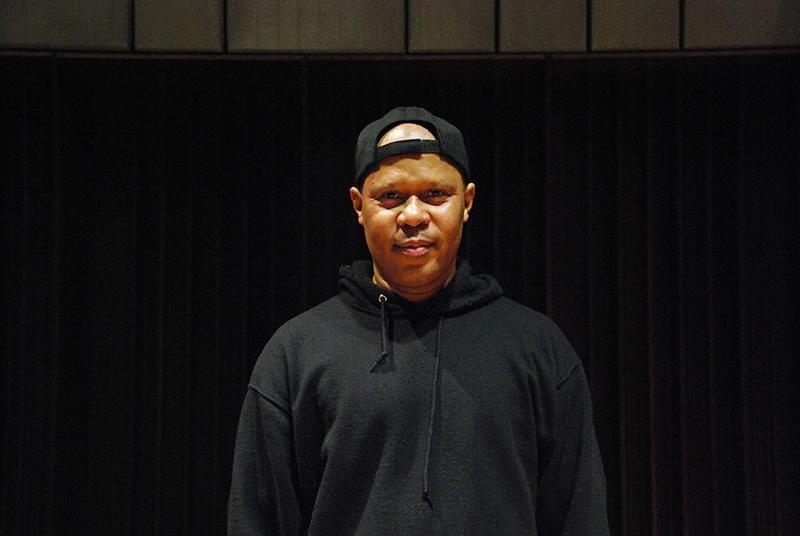On the Record with Steve Coleman, saxophonist and composer
Steve Coleman, a renowned saxophonist and improvisational composer, who played at the ’Sco and gave a master class on Wednesday
May 8, 2015
Steve Coleman is a saxophonist, composer and bandleader from Chicago’s South Side. Coleman’s complex style, which emphasizes polyrhythmic meter and unorthodox tonalities, falls outside the realm of categorization. The Review spoke to Coleman on the phone just before his show at the ’Sco Tuesday night about everything from playing in Cecil Taylor’s big band to parallels between music and language.
How did you develop your personal sound? Who are your early musical influences?
My early musical influences are things I heard on the radio at the time. Later on, as I got into improvising, I got into people like Charlie Parker, John Coltrane and Sonny Rollins — the kind of people that a lot of people listen to. I also listened to a lot of local players in my area, particularly one named Bucky Green. Those are my earliest influences.
You’ve traveled to Ghana, Cuba, India and other countries. How have those trips affected your musical outlook?
As a musician, traveling anywhere just broadens your outlook. That’s what I would say: It [changed] my point of view and how I look at the musical world. It broadened my whole palette. I was in Africa mainly to study the relationship between music and language. Communication — that’s the main reason I went. I wanted to check out how [they] use music as a language. I’m not so much into music as entertainment, but more as a means to communicate.
Can you tell me about your band, Five Elements?
The lineup is constantly changing — the “Five” doesn’t refer to the number of people in the group. [For the Oberlin gig]the lineup consists of people who I’ve been working with for a long time. I’ve been working with the drummer and the bass player since the mid-’90s. The trumpet player’s been working with me since 2000 and the guitar player since 2007 or so. They’re not new members or anything like that. But [the lineup has] changed over time; a lot of it can be based on the ability of the musicians. Different musicians join paths for different reasons — sometimes you can’t hold a musician because you can’t pay them enough. [Laughs.]
There are polyrhythms and other complex elements in a lot of your music, so I’d imagine playing with people you’ve worked with for a long time must be helpful.
Yeah, that’s very important: which musicians you work with. Everybody thinks it’s important, but it’s especially important with [Five Elements] because not just anybody can just jump in and play. It takes a lot of preparation, even though there’s a lot of spontaneous composition.
Can you tell me about this term spontaneous composition? You prefer this term to jazz in terms of categorization. Why is that?
A lot of people don’t like the term jazz, not just me. It doesn’t say anything, you know? Spontaneous composition, to me, says what the music is. When saying “jazz,” you could be talking about anything. People think so-called jazz consists of different things depending on who they are. Somebody might think it’s Kenny G, somebody else might think it’s Louis Armstrong. It’s a term that musicians have never really liked. Duke Ellington and [other musicians] never really liked the term because it doesn’t really mean anything.
Do you feel like the term spontaneous composition says more?
Well, yeah, because that’s what we’re doing. We’re composing spontaneously. So at least it’s descriptive. The term jazz is not even descriptive. People use it as a marketing term.
You’re a very prolific musician. Do any of your records stand out to you as particularly successful or unsuccessful? Do you have favorites or least favorites?
Usually my favorite is whatever I did last. I’m always thinking about what I’m trying to do next. Favorite is a hard word, though. I’m more focused on my most recent work; I’m not focused on what happened 10 years ago or 20 years ago. There are projects that I think turned out okay, like The Sonic Language of Myth, but I’m not thinking about that; that was years ago.
Your most recent record was Synovial Joints. Can you talk about the half-waking vision you had that eventually led to the recording of this album?
This was a dream that I had in January 2013 in Bahia, Brazil. The first part of the vision involved me working with percussionists from Bahia and Matanzas, Cuba. The second part involved combining these sounds with instruments from Eurasia, particularly Western Europe — instruments more commonly found in an orchestra.
The idea was to compose using long rhythmic sentences, where I would create these long rhythmic phrases in counterpoint to other long phrases, to create polyphonic and polyrhythmic texture compositions. I believe that the basic melodic-rhythmic language of this tradition that I am a part of is unique. The basis of the rhythmic conception existed on the African continent but not in this exact form that we are utilizing today. The underlying principles of the harmonic ideas existed on the Eurasian continent. The melodic elements, although somewhat based on 12-tone equal temperament, are quite a departure from what had occurred in Eurasia or Africa in terms of contour, movement and vibe.
Together this all creates a very different use of color. The melodic and rhythmic language together create a totally different music. And the melodic and rhythmic language together imply very different harmonic textures — a kind of organic harmony that grows out of the melodic and rhythmic material. In this approach, the form of the rhythms and melodies dictate the harmony, not the other way around.
How did playing in big bands in New York influence you? What was it like playing in Cecil Taylor’s big band?
Playing in big bands taught me discipline. Also, much of the music that I compose for large ensembles is influenced by my work in large ensembles. Playing gigs with Cecil Taylor’s large ensemble was a transformative experience for me. Just to get to work with Cecil was transformative. Mr. Taylor demonstrated to me how to express musical ideas using an oral tradition outside of writing things down on paper.
Interview by Danny Evans


























